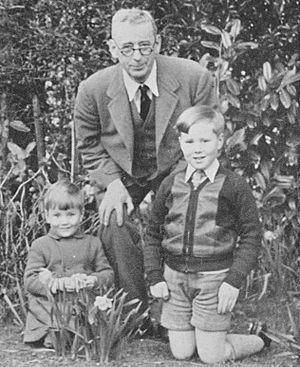Frederick Noel Ashcroft facts for kids
Frederick Noel Ashcroft (born 1878, died 1949) was a British scientist. He was famous for collecting minerals and taking scientific photos. His huge collections, gathered between 1914 and 1938, are now kept at the Natural History Museum in London.
Contents
Early Life and Education
Frederick Noel Ashcroft was born in 1878 in Wavertree, Liverpool. His family had German roots. He went to Rugby School starting in 1892. Later, in 1897, he studied at Magdalen College, Oxford. He earned a top degree in Chemistry in 1901.
After Oxford, he did more research in Chemistry at University College, London. While at Oxford, he also learned about minerals from his teacher, Henry Alexander Miers. This sparked his interest in minerals. This interest shaped his future work. Because of poor health, he could not take on a full-time job.
Collecting Minerals and Photography
Frederick Ashcroft first focused on collecting zeolites. These are a type of mineral. He collected them between 1901 and the start of World War I. During this time, he gathered about 2,000 mineral samples. They came from 80 different places, mostly in Europe and America. He gave this collection to the British Museum (Natural History) in 1914.
Before World War I, he also collected zeolites in Ireland. He found samples from about 90 places, especially in County Antrim. This collection was given to the British Museum (Natural History) after he passed away in 1949.
Swiss Mineral Collection
After World War I ended, Ashcroft became interested in Switzerland. He visited Switzerland every year. He met all the important mineral experts and local collectors there. He bought many beautiful mineral samples from these collectors. Many of them were mountain guides.
He had one important rule for buying specimens. He had to know the exact place where each mineral was found. If possible, he wanted to visit and check the location himself. He would take photos of these sites. Prints of his photos helped him mark the exact spots where he found minerals. For this, he used a large camera with a heavy tripod. He believed smaller cameras did not give good enough pictures for his work.
He gave his entire Swiss Collection to the British Museum (Natural History). This collection had over 6,000 mineral samples. He gave them between 1921 and 1938. The notes and all the photo negatives related to this collection also went to the museum after his death.
His gifts to the museum were very important. They were more than any other person had given to the Mineralogy Department.
Societies and Committees
Ashcroft was a very active member of the Royal Mineralogical Society. He served as their treasurer for twenty years. He was also the president of the society from 1942 to 1945.
He was also an important member of the Geological Society of London. He worked as their treasurer from 1929 to 1947. In 1948, he was the treasurer for the 18th International Geological Congress. This big meeting was held in London in August 1948.
Personal Life
Frederick Ashcroft married Muriel Im Thurn in 1904. She was the niece of Everard im Thurn. They had two daughters and two sons. His younger son, Michael Ashcroft, was a codebreaker. He worked at Bletchley Park during World War II. He worked in Hut 8 under the famous scientist Alan Turing.
Ashcroft also had a small but very special collection of jade and Chinese pottery.


